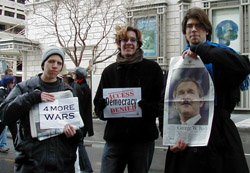
|
|
|
Politics
Main Page |
| Maryland
Protesters Scattered in Organization, United in Opposition to Bush
By Kathleen Cullinan WASHINGTON - Sharon Broderick had never been to a protest before, and was not sure if she should join the thousands who marched Thursday against President Bush's second inauguration. Protesting is "not really my style," said the 47-year-old school teacher from Columbia, but ultimately her concerns about the economy and Iraq outweighed her distaste for confrontation. "I'm really, really scared. For me this is a huge leap," said Broderick, who was sporting pink and blue protest pins on her puffy winter coat at an early morning women's rally. "I just think it's time." Broderick was one of many Marylanders who popped up at rallies around Washington on Thursday, protests that started jubilantly in the morning but frayed into frustration and occasional confrontation as the day wore on. Not far from Broderick, Baltimore resident Mary Ruth Zier, 20, was protesting the Bush administration's "really, really huge pile of lies." Zier said she was not deterred by reports that space for demonstrators would be limited at the inaugural parade. "I think the whole country's a free-speech zone," she said. The early morning rally, organized by the National Organization for Women, Code Pink and others, was supposed to merge with other demonstrations as they filed through the streets of Northwest Washington on their way to a park near the White House. Organizers of the larger march, led in part by the D.C. Anti-War Network, anticipated crowds of several thousand. Demonstrators from as far as Ohio, Florida, California and Kansas came -- some arriving in Thursday's pre-dawn hours without hotel reservations -- and toted colorful placards, banged drums and chanted as they strolled down freshly plowed streets. "I'm frigid," said Jennifer Boyer, 30, an editor from Wheaton who inched along with the crowd at the opening of the DAWN march. But in light of the war and concerns over the environment, Boyer "wanted to do it anyway." Supporters -- and a handful of counter-protesters -- greeted the chanting, dancing crowds as they made their way toward the White House. Spectators stood in the windows of a Planned Parenthood office along the route, cheering and flashing peace signs, sparking waves of supportive applause and screams from the protesters in response. As hundreds of protesters rounded the final corner before the park, they were confronted by a woman waving a pennant and shouting, "God chooses the president! God makes war!" One man stopped and yelled back at her for a moment, but the woman, indifferent, kept up her chant. The crowds reached the park and started to disperse early in the afternoon. Some made their way down to the inaugural parade, forming lines that spanned entire blocks leading to the parade entrances, where ticket-holders with Bush campaign regalia found themselves mingling with protesters who were still holding their signs. Tension mounted when police closed the entrances, even to ticketed spectators who were still in line. "I guess the protesters got to protest. But whose freedoms are being violated?" said David Winkler, 55. The Bethesda man and his family were still in line with their parade tickets when police sealed the entrances. But Silver Spring resident George English said his right to protest was violated when police ripped a cardboard tube from his "Hail to the Thief" posters. English, 64, thought he was following directions when he used the tube to hold his sign rather than a pole or a stick, which were banned from the parade. "I didn't expect to be manhandled like that," said English, a retired civil servant who said his last protest of an inauguration was when Richard Nixon was president. The parade was late starting, and difficult to see past fenced-off streets and a wall of bleachers. With patience waning as the day wore on, protesters and riot police ambled about and occasionally sparred, with fur-clad inauguration guests darting around them on their way out of the parade, until evening fell. With no mass plan for the next place to go, clumps of people started to drift away. But one protester, still energetic if slightly reluctant to seize the lead, tried to rally the troops for more. "Festive march at Dupont Circle starting really soon!" he shouted, before looking around and checking his confidence. "Or, you know."
Copyright ©
2005 University of Maryland Philip Merrill College of
Journalism
|

